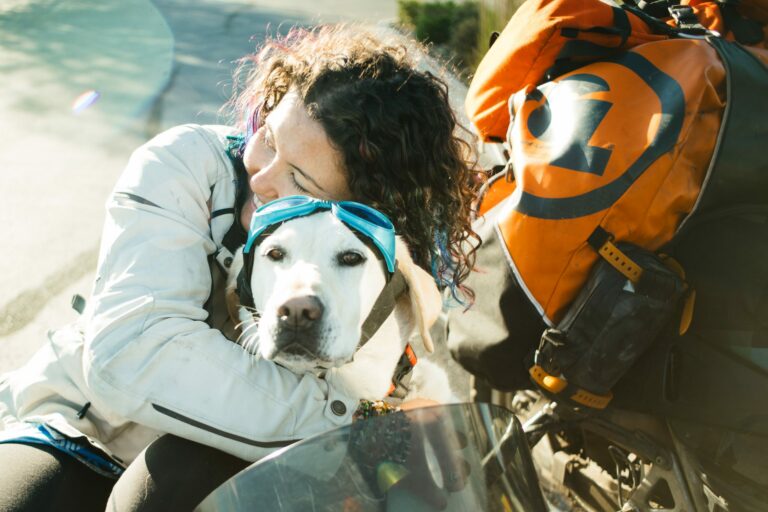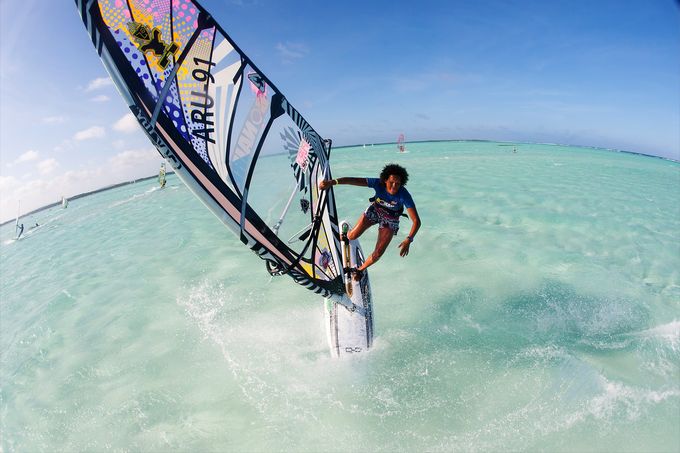
It’s hard to make a living from windsurfing – particularly for woman. But Sarah-Quita Offringa is testament to the fact that it is definitely possible.
When I first arrived at the Professional Windsurfers Association World Championships in Tenerife, everyone told me I should speak to Sarah-Quita.
Meet The Windsurfing Twins Who Have 24 World Titles, Battled Cancer & Aren’t Quitting Any Time Soon
With seven PWA World Championship titles under her belt, she’s a truly great female windsurfer.
You can’t miss her. With a distinctive mane of curly hair, Sarah-Quita has the kind of vivacious personality that brings life to a room full of nervous competitors.

While waiting to compete, she clearly loves joking around with her mates backstage – but that doesn’t mean she is any less determined to win.
Hailing from the tiny, windy Caribbean island of Aruba, windsurfing has been Sarah-Quita’s life for the last decade.
She now competes in three disciplines – freestyle, slalom and wave – but she hasn’t always taken naturally to windsurfing. In fact, when she first started out aged nine, she didn’t like it at all.
“My parents wanted my brother and I to try out a lot of things to see what we would like. We went to the beach to learn to windsurf. I was really bad at it – I was too weak to lift up the sail.”
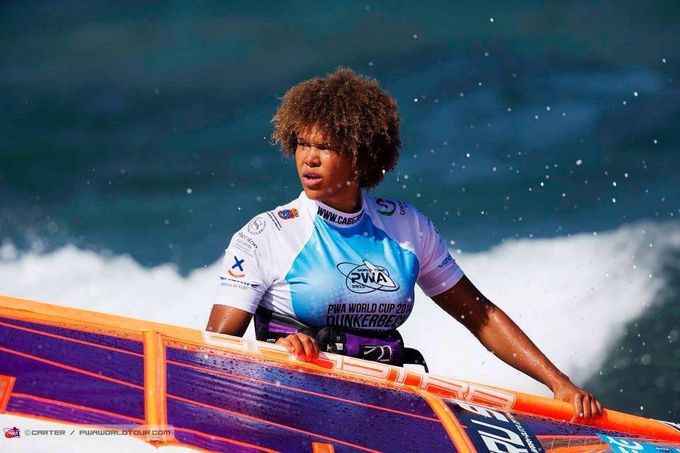
It wasn’t until a year later when she went down to watch the Aruba Hi Winds – the biggest Caribbean windsurf event – that she saw how much fun everyone as having. “So I said to my mum I want to try again.”
“When I started windsurfing, I was one of the only girls. I was surrounded by boys – windsurfers from Bonaire. They are so good on the water. They are always smiling and having a good time – and for me that represents windsurfing.”
Since the age of 14, Sarah-Quita has been on the PWA World Tour competing with the world’s finest windsurfers. For the last decade, she has been travelling the world and windsurfing in some of the best spots.
It might seem like a dream job – hopping between the Canary Islands, Korea and Hawaii for eight months of the year – but it’s not as easy as it might seem.
As long as the windsurfing industry doesn’t add value to [women], people from outside are not going to see it either
Most windsurfers on the tour rely almost entirely on support from their sponsors to continue competing. In 2014, Sarah-Quita had no sail sponsor, which in the world of professional windsurfing is a big deal.
“I decided to stop with my sponsor in December 2013 – and all the other brand’s budgets were closed. I knew this could have been a possibility, so I took responsibility for it.”
Even as seven time world champion, no one could help Sarah-Quita. She managed to compete that year regardless, but it was tough.
“I really had the minimal amount of stuff. I was so scared at one event that my mast and boom would break – because then I wouldn’t have anything extra and that would be it.”
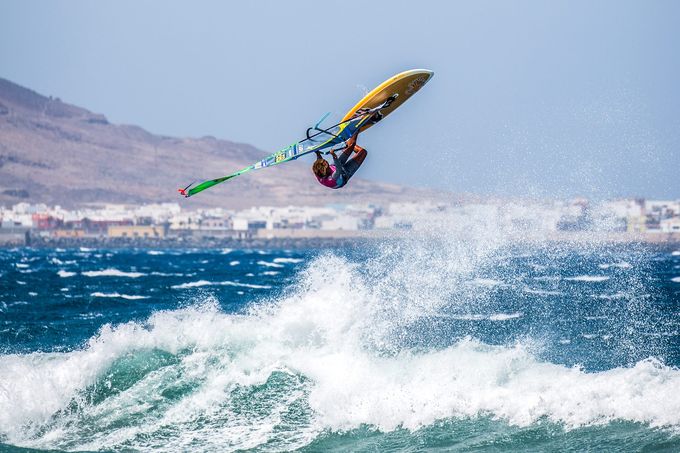
But is it possible to make a living from windsurfing? Sarah-Quita pauses. “I compete and travel for free, but it’s not like I’m earning that much. As long as I do well and win some prize money, I can cover my expenses.”
But it’s tough, as we heard from the Moreno twins, particularly for female athletes where sponsorship is harder to come by.
“There really is a big difference between men and women. In the last two years, the women’s level has got a lot better. But men still get more coverage than we do. Companies focus on men more because they sell more equipment for them.”
While in surfing, clothing brands like Roxy and Billabong sponsor female athletes, it’s not the same in windsurfing. Equipment brands are the main sponsors.
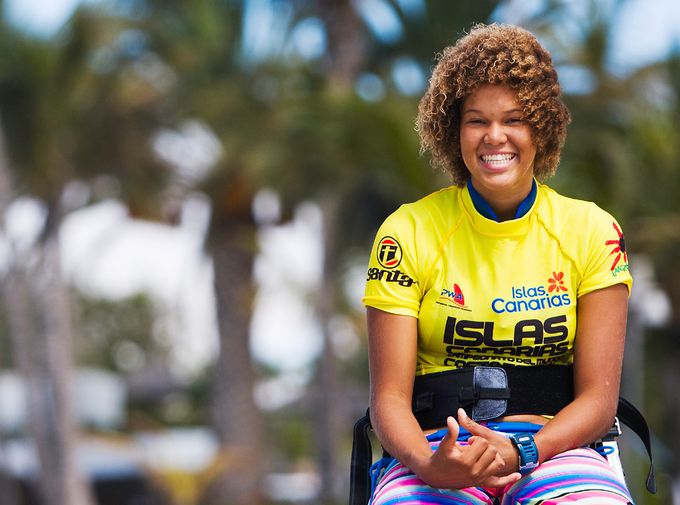
Sarah-Quita points at a promotional poster of a guy windsurfing. “See, that could be a woman. As long as the windsurfing industry doesn’t add value to us [as women], people from outside are not going to see it either.”
“All brands that sponsor women should give women the spotlight more in their catalogues and adverts,” she says.
Is it just a case of there being less women in windsurfing? “There are more women into windsurfing than before, but a lot are intimidated by competing.”
I love windsurfing. Everywhere you go, you meet special people. For me, that makes it really worth it.
“I know so many women that are really good. I say to them, ‘You should come and compete’. But they don’t think they are at the level to be good enough. I disagree – I think through competing you improve.”
For Sarah-Quita, who has been on tour since the age of 14, windsurfing competitions are all she’s ever known – but even passionate windsurfers need interests outside the water.
Last year, she finished her degree in science and innovation management in Holland – and is hoping to do a masters in the next few years.
“After high school, I did one year of windsurfing and I realised that even though it’s my biggest passion, I get bored of it as well. After six months, my friends were already in Holland studying and I was like, I want do that too.”
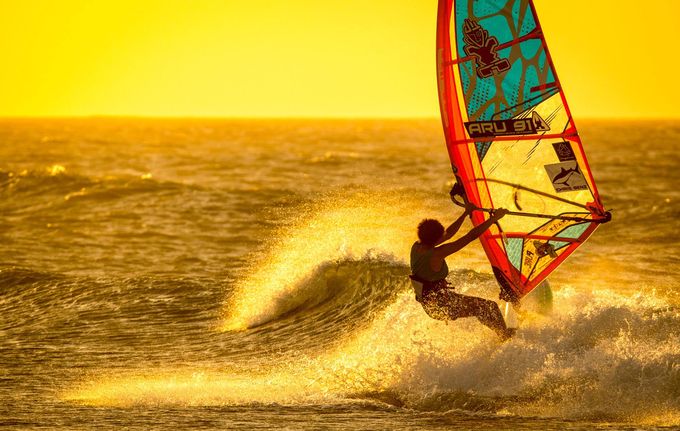
“Windsurfing is great, but you need the mental challenge as well. It’s just a tricky thing to balance.”
But like any student, by the end of her degree, she was itching to get back out into the world and travel once more.
“I love windsurfing – it’s more about the lifestyle than just the sport. Everywhere you go, you meet special, friendly, cool people. For me, that makes it really worth it.”
So, it is possible to make a living as a windsurfer? The answer is firmly yes, but it’s not easy. Nothing worth having ever is though, right?
The PWA World Tour took place in El Medano, Tenerife from 3 to 7 August 2015. Thank you to the Tenerife Tourism Corporation and Monarch Airlines for hosting us.
Monarch operates scheduled flights to Tenerife from Birmingham, East Midlands, Leeds Bradford, London Gatwick, London Luton and Manchester airports with fares, including taxes, starting from £39.99 one way. www.monarch.co.uk




